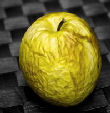
Purpose
To create a mummified apple by removing the moisture from the apple and preventing bacteria from growing.
Additional information
Mummies of humans and animals have been found throughout the world, some as a result of natural preservation and some as the result of human-assisted preservation. The most famous and well known culture for preserving the dead through mummification were the ancient Egyptians. Although mummification existed before the Egyptians with the Chinchorro mummies from northern Chile, the Egyptians were focused on the prospect of eternal life, which meant preserving the body for eternity.
The earliest process of mummification took place as early as 3000 BC. Organs were removed from the body, with the exception of the heart, and stored in canopic jars. The skulls of the dead would then be filled with a thick plant-resin or plant-resin sawdust. It wasn't until the Middle Kingdom that the process began to take on a more advanced form. After removing organs and the brain (often pulled from the nostrils with hooks), embalmers would use natural salts to remove moisture from the bodies of the dead, drying out flesh and bone. The emptied bodies were then covered in natron to speed up the dehydration process and prevent decomposition. They were then wrapped with white linen and finally wrapped with a sheet of canvas for extra protection before being laid to rest.
Sponsored Links
Required materials
- 1 Apple
- 1 Popsicle stick
- 1 Plastic bag (preferably a zip-lock freezer bag)
- 1/4 cup of salt
- 1/2 cup of sodium carbonate (powdered bleach)
- 1/2 cup bicarbonate of soda (sodium bicarbonate, which is used as a raising agent in baking)
Estimated Experiment Time
About 10 minutes to conduct, and a few days for the apple to become mummified.
Step-By-Step Procedure
- 1. Mix the salt, sodium carbonate, and bicarbonate of soda into the plastic bag.
- 2. Cut a face into your apple using the popsicle stick. Do this by pushing the stick into the front of the apple to make eyes, a nose, and a mouth (be creative).
- 3. When finished with the face, push the popsicle stick into the top of the apple so it makes a handle.
- 4. Place the apple into the bag with the mixture and ensure that it's covered by the mixture
- 5. Leave the bag open in a warm dry place and watch what happens to the apple!
Note
This apple is NOT meant to be eaten! Once you take a look at the final result you'll probably agree it isn't something you would consume. Besides, who would want to eat a mummy?
Observation
Why do you think the apple dried and shriveled as opposed to turning brown and decaying? Does the apple even resemble an apple once it's all dried up, or does it look more like a shriveled up prune? How is the process of mummifying the apply similar to the process used by ancient civilizations in mummifying their dead?
Result
The powder mixture takes all the moisture out of the apple, which makes it difficult for bacteria to grow. Without the water and bacteria, the apple can't decay, so it just shrivels and dries up. Again... DO NOT EAT THIS APPLE!
Sponsored Links
Take a moment to visit our table of Periodic Elements page where you can get an in-depth view of all the elements,
complete with the industry first side-by-side element comparisons!